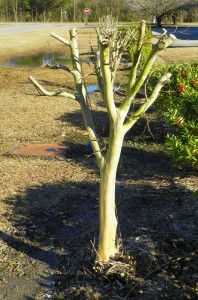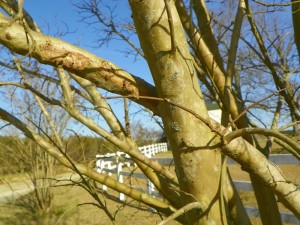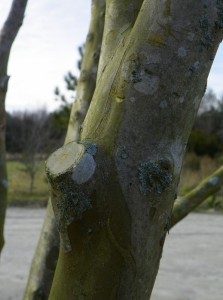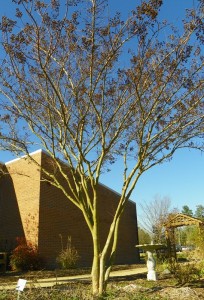How Do I Prune Crape Myrtle?
go.ncsu.edu/readext?201699
en Español / em Português
El inglés es el idioma de control de esta página. En la medida en que haya algún conflicto entre la traducción al inglés y la traducción, el inglés prevalece.
Al hacer clic en el enlace de traducción se activa un servicio de traducción gratuito para convertir la página al español. Al igual que con cualquier traducción por Internet, la conversión no es sensible al contexto y puede que no traduzca el texto en su significado original. NC State Extension no garantiza la exactitud del texto traducido. Por favor, tenga en cuenta que algunas aplicaciones y/o servicios pueden no funcionar como se espera cuando se traducen.
Português
Inglês é o idioma de controle desta página. Na medida que haja algum conflito entre o texto original em Inglês e a tradução, o Inglês prevalece.
Ao clicar no link de tradução, um serviço gratuito de tradução será ativado para converter a página para o Português. Como em qualquer tradução pela internet, a conversão não é sensivel ao contexto e pode não ocorrer a tradução para o significado orginal. O serviço de Extensão da Carolina do Norte (NC State Extension) não garante a exatidão do texto traduzido. Por favor, observe que algumas funções ou serviços podem não funcionar como esperado após a tradução.
English
English is the controlling language of this page. To the extent there is any conflict between the English text and the translation, English controls.
Clicking on the translation link activates a free translation service to convert the page to Spanish. As with any Internet translation, the conversion is not context-sensitive and may not translate the text to its original meaning. NC State Extension does not guarantee the accuracy of the translated text. Please note that some applications and/or services may not function as expected when translated.
Collapse ▲Too often crape myrtles are cut back to bare trunks in the belief this abuse will yield more flowers. In reality this type of severe pruning results in a shorter bloom time, delayed flowering, weaker branching, and can increase insect and disease problems. This practice, known as topping, is harmful to all trees and is never the right way to prune a crape myrtle.
The Right Way to Prune Crape Myrtle
Late winter (February-March) is the best time to prune crape myrtles in eastern North Carolina. Like all trees, the correct way to prune a crape myrtle involves enhancing its natural form rather than trying to force it to grow in a space that is too small or an artificial shape. Crape myrtles naturally grow as small upright or vase shaped trees with multiple trunks. In a well pruned crape myrtle, the trunks grow upward and outward, with branches fanning out rather than growing inward into the center of the tree.
To determine if your crape myrtle needs to be pruned, examine the direction in which the trunks and branches grow. Starting at ground level, follow the trunks upward to where they begin to branch, focusing on the interior of the tree rather than the outer edges. Branches that grow into the center of the tree, crossing over other branches or trunks, should be removed.
To remove a branch, follow it back to where it joins a larger branch or trunk. Take a close look at the point where the branch joins the trunk. You will notice at the point where the two join the branch is swollen or enlarged. This area is known as the branch collar. Using a pruning saw, remove the branch by cutting just above the branch collar rather than flush with the trunk. If the branch was removed at the correct place the branch collar left behind will extend out a centimeter or two from the trunk.
If it has been years since the tree was last pruned you may have to remove several branches. Whole trunks can be removed by cutting them off as close to ground level as possible, but this results in profuse sprouting of suckers during the summer and should be done only as a last resort.
If you have the time and the tree is not too large, you can clean up the interior of the tree by cutting off small twiggy branches that grow from the main trunks. This is best done using hand pruners. You can also remove seed pods and trim off the ends of branches that are less than pencil sized in diameter. While these practices will help the tree look neater and may increase the size of flower clusters, they are not necessary to keep the tree healthy.
Reducing Tree Size
Crape myrtle varieties like ‘Natchez’, ‘Muskogee’ and ‘Tuskegee’ easily reach twenty five feet tall or higher with a similar spread. If you have planted a large growing variety in a space that is too small to allow it to mature your best option is to move the tree to a different spot and replace it with a more compact selection such as ‘Tonto’, ‘Sioux’ or ‘Catawba’, which grow to fifteen feet or less. For help selecting the right variety of crape myrtle for you site, visit this Clemson Extension website.
If moving the tree is not an option, you can reduce tree height and width by cutting back the tallest and most wide spreading branches at the point where they join another branch. Known as reduction pruning, this method preserves the natural shape of the tree and is infinitely preferable to topping. Learn more about reduction pruning from this Florida Extension website.
Keeping a large growing variety confined to a small space will require annual pruning. Minimizing irrigation and fertilizer applications can also help keep these trees in bounds.
LEARN MORE
Learn more about the right way to prune crape myrtle from these great website:
Other summer flowering trees and shrubs that should be pruned in February include roses, butterfly bush, and chaste tree. Learn more about pruning ornamental plants from the N.C. Cooperative Extension publication, Pruning Trees and Shrubs.
Visit your local Cooperative Extension office to learn more about gardening and landscape care. Go to https://www.ces.ncsu.edu/local-county-center/ to find your county Extension center.







